#Constance of Castile
Explore tagged Tumblr posts
Text
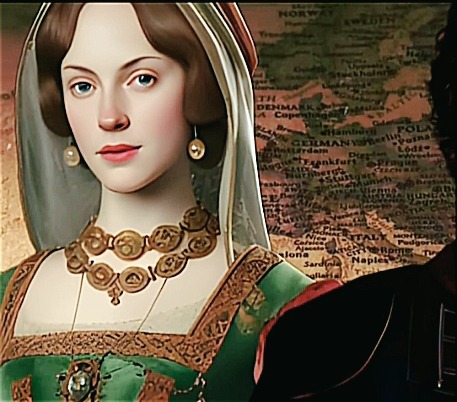

The triangle Constance of Castile, John of Gaunt and Katherine Swynford
Part One
Katherine Swynford and John of Gaunt met whilst she was in the service of his first Duchess, Blanche, as a chamber servant. During this time, the two women were on close terms, for Katherine’s own daughter, Blanche Swynford, was placed in the same chamber as both Philippa and Elizabeth – the daughters of Blanche of Lancaster – and Gaunt was appointed as her godfather. Katherine was married to one of Gaunt’s retainers, Sir Hugh Swynford, who held a manor in Kettlethorpe in Lincolnshire. Hugh Swynford suddenly died, whilst serving John of Gaunt in Aquitaine. He left Kettlethorpe in the possession of Katherine and his son and heir Thomas, who was four years old. Hugh Swynford’s land and house were part of the Duchy of Lancaster, and as his Lord, John of Gaunt dutifully ensured the welfare of his family. He employed Katherine in his household as a ‘maistresse’ – a governess – to his daughters, and appointed her sister Philippa, the wife of Geoffrey Chaucer, to serve Duchess Constance.
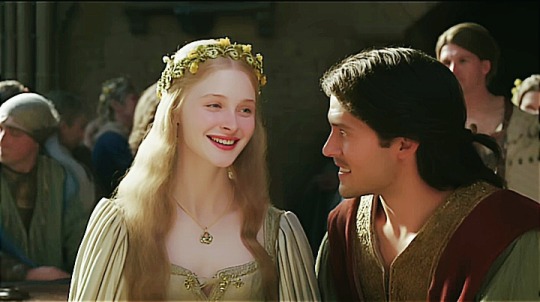
In spring 1372, shortly after John of Gaunt paraded Constance through London, he gifted Katherine a generous sum of money. This is the first record of his direct association with her, and it is likely that around this time she became his mistress. Katherine’s conveyance of the news of Princess Catalina’s birth to the King suggests that she had been in attendance; having borne at least four children of her own at a young age, she would have been able to reassure and support Constance through her ordeal. But as soon as her own pregnancy became obvious, a pregnancy that could not have been her husband’s doing, she would have been obliged to resign her post and return to Kettlethorpe.
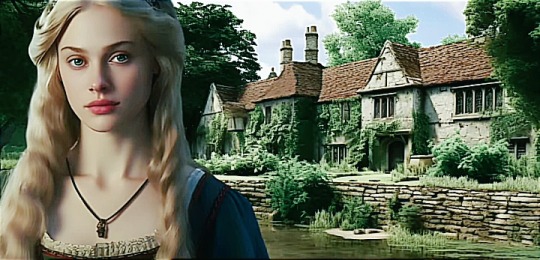
In 1373, the first son of the lovers couple, John, was born and given the surname Beaufort. Following his birth, John of Gaunt granted Katherine more money as well as a lucrative marriage agreement for her daughter Blanche. John Beaufort’s early years were probably spent at Kettlethorpe. The pattern of John’s grants to Katherine, some of them concerning its refurbishment, some of them handsome gifts, may indicate the dates of birth of their other children, and certainly suggests that the manor was being made a fit place for them to be brought up in. Kettlethorpe was a remote village with a tiny population, an ideal setting for discreet confinements and the raising of royal bastards whose existence was better kept secret – at least for the present.

Certainly the lovers were discreet, at least to begin with – had they not been, the world would soon have known of their affair, and we would not have to rely on inference and speculation in determining the circumstances in which it began. Costain argues that it was Katherine who insisted on secrecy in the early years of the liaison – she was, after all, newly widowed – but there were political imperatives to be considered too: John would not have wished to openly dishonour his new wife when all his hopes were centred on claiming the crown of Castile in her right. Thus the need for discretion was probably mutual, and it ensured that for some years to come, his affair with Katherine was conducted in secrecy and with great circumspection.
Sadly for those romantics who would prefer to believe that the Duke stayed true to Katherine within the limits of their adulterous relationship, there is some evidence that he had fleeting sexual encounters with other women during the course of it. In 1381, he was publicly to confess that he had committed the sin of lechery with Katherine herself ‘and many others in his wife’s household’. Probably John’s amours were fleeting and purely physical – and made no impact on his obviously deep feelings for Katherine Swynford.

Yet it appears that the Duchess’s Castilian ladies were already aware in 1373 that Katherine was John’s mistress. Their gossiping so annoyed the Duke that he packed them all off to Nuneaton Abbey, hoping that the Abbess would teach them discretion. If her ladies knew what was going on between the Duke and Katherine, the chances are that Constance did too.
By 1375 Katherine's position of influence with the Duke was becoming public knowledge. Although there are very few known instances of her exercising any powers of patronage, the Leicester records show that she occasionally used her influence for the benefit of others, while there is evidence to suggest that if she did ask favours from the Duke, it was usually for her own family members.
The public and liberal relationship that Gaunt and Katherine enjoyed after 1377 was due to Gaunt’s shift in position after the death of Edward III. He was the uncle of King Richard II, the most powerful noble in the country, a Prince, and even a King himself; he was powerful enough to conduct the affair without fearing the consequences. Katherine accompanied John of Gaunt that summer as he toured his extensive Duchy lands – the towns and villages where he was most at ease and felt confident in the love of the people. It was certainly at the request of John of Gaunt, within weeks of Richard’s ascension, that Katherine was granted two wealthy manor estates for life, in exchange for Gaunt’s county of Richmond. This generous gift – at the cost of his own property – is testament to Gaunt’s respect and love for Katherine Swynford in the late 1370s.
Sources:
Alison Weir, KATHERINE SWYNFORD: THE STORY OF JOHN OF GAUNT AND HIS SCANDALOUS DUCHESS
Helen Carr, THE RED PRINCE: THE LIFE OF JOHN OF GAUNT, THE DUKE OF LANCASTER
Images from youtube's video:
youtube
#constance of castile#john of gaunt#katherine swynford#constanza de castilla#constanza of castile#geofrey chaucer#richard ii#hugh swynford#john beaufort#english history#lancaster#Youtube
10 notes
·
View notes
Text
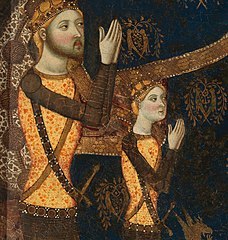


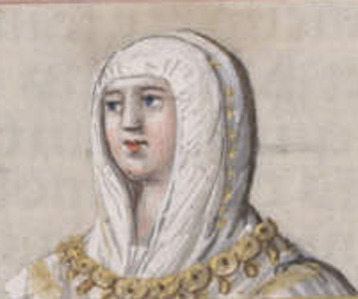

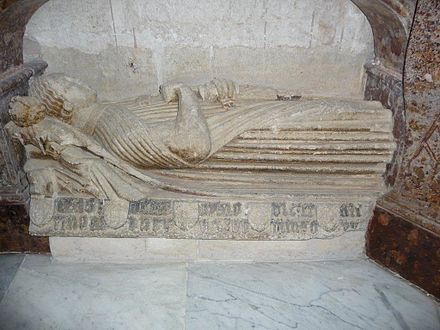

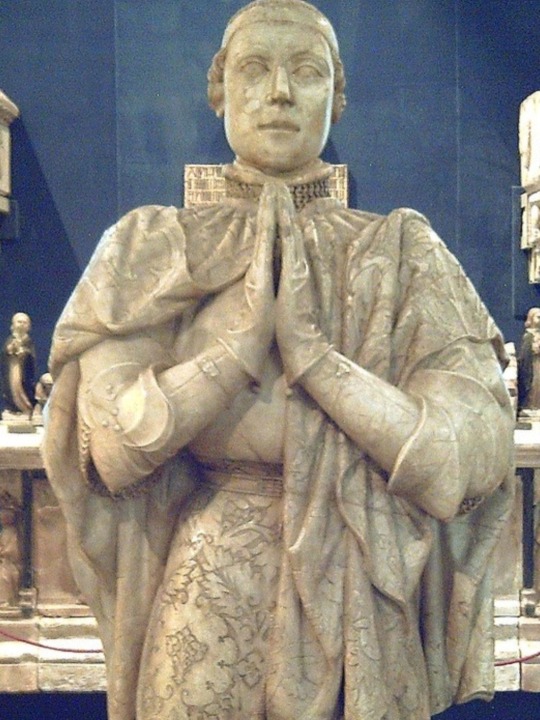

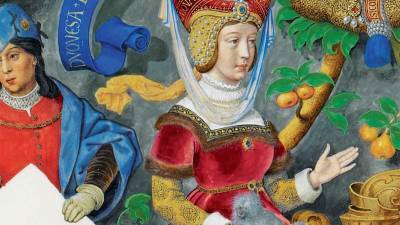
The Bastard Kings and their families
This is series of posts are complementary to this historical parallels post from the JON SNOW FORTNIGHT EVENT, and it's purpouse to discover the lives of medieval bastard kings, and the following posts are meant to collect portraits of those kings and their close relatives.
In many cases it's difficult to find contemporary art of their period, so some of the portrayals are subsequent.
1) Henry II of Castile ( 1334 – 1379), son of Alfonso XI of Castile and Leonor de Guzmán; and his son with Juana Manuel de Villena, John I of Castile (1358 – 1390)
2) His wife, Juana Manuel de Villena (1339 – 1381), daughter of Juan Manuel de Villena and his wife Blanca de la Cerda y Lara; with their daughter, Eleanor of Castile (1363 – 1415/1416)
3) His father, Alfonso XI of Castile (1311 – 1350), son of Ferdinand IV of Castile and his wife Constance of Portugal
4) His mother, Leonor de Guzmán y Ponce de León (1310–1351), daughter of Pedro Núñez de Guzmán and his wife Beatriz Ponce de León
5) His brother, Tello Alfonso of Castile (1337–1370), son of Alfonso XI of Castile and Leonor de Guzmán
6) His brother, Sancho Alfonso of Castile (1343–1375), son of Alfonso XI of Castile and Leonor de Guzmán
7) Daughters in law:
I. Eleonor of Aragon (20 February 1358 – 13 August 1382), daughter of Peter IV of Aragon and his wife Eleanor of Sicily; John I of Castile's first wife
II. Beatrice of Portugal (1373 – c. 1420) daughter of Ferdinand I of Portugal and his wife Leonor Teles de Meneses; John I of Castile's second wife
Son in law:
III. Charles III of Navarre (1361 –1425), son of Charles II of Navarre and Joan of Valois; Eleanor of Castile's huband
8) His brother, Peter I of Castile (1334 – 1369), son of Alfonso XI of Castile and Mary of Portugal
9) His niece, Isabella of Castile (1355 – 1392), daughter of Peter I of Castile and María de Padilla
10) His niece, Constance of Castile (1354 – 1394), daughter of Peter I of Castile and María de Padilla
#jonsnowfortnightevent2023#henry ii of castile#john i of castile#juana manuel de villena#eleanor of castile#alfonso xi of castile#leonor de guzmán#tello alfonso of castile#sancho alfonso of castile#peter i of castile#constance of castile#isabella of castile#asoiaf#a song of ice and fire#day 10#echoes of the past#historical parallels#medieval bastard kings#bastard kings and their families#eleanor of aragon#beatrice of portugal#charles iii of navarre#canonjonsnow
17 notes
·
View notes
Text
"To all intents and purposes she may be counted among the kings of France"

The hour that struck the death of Louis VIII was arguably the most critical in the history of the Capetian family. The new king, one day to be St Louis, was still a child. The trend of events in the previous two reigns had brought the higher nobility to realise that its independence would soon be seriously threatened. But a unique opportunity was raised to the regency of the queen-mother, Blanche of Castile, on the pretext that she was a woman and a foreigner. Yet this was not the first occasion on which the king's widow had acted as regent, nor the first on which a queen had played a part in politics. Philip Augustus had been the first Capetian not to involve his wife in the government of his realm. Before his time the queens of France had often intervened in affairs of state. Constance of Arles, not content with making married life difficult for Robert the Pious, had wanted to change the order of succession to the throne. She had led the opposition to Henri I, provoking and upholding his brothers against him, and she was perhaps responsible for the separation of Burgundy from the royal domain, to which Robert the Pious had joined it. Anna of Kiev, after the death of her husband Henri I, had been one of the regents, and it was only her second marriage, to Raoul de Crépy, that took her out of politics. Bertrada de Montfort's influence over Philip I had been notorious, and so had her hostility to the heir to the throne, whom she had even been accused of trying to poison. Adelaide of Maurienne, despite a physical personality before which Count Baldwin III of Hainault is said to have recoiled, had held considerable sway over Louis VI, procuring the disgrace of the chancellor, Etienne de Garlande, and egging on Louis to the Flemish adventure from which her brother-in-law, William Clito, was to profit so much. Eleanor of Aquitaine- as St Bernard had complained- had more power than anyone else over Louis VII as long as their marriage lasted. Louis VII's third wife, Adela of Champagne, had appealed to the king of England for help against her son Philip Augustus when he had sought to free himself of the tutelage of her brothers of Champagne. Later, reconciled with Philip, Adela had been regent during his absence from France on crusade. From the beginnings of Capet rule, the queens of France had enjoyed substantial influence over their husbands and over royal policy.
But Blanche of Castile was to play a greater role than any of her predecessors. To all intents and purposes she may be counted among the kings of France. For from 1226 until her death in 1252 she governed the kingdom. Twice she was regent: from 1226 to 1234, while Louis IX was a minor, and from 1248 to 1252 during his first absence on crusade. Between 1234 and 1248 Blanche bore no official title, but her power was no less effective. Severe in personality, heroic in stature, this Spanish princess took control of the fortunes of the dynasty and the kingdom in outstandingly difficult circumstances. For in 1226 there arose the most redoubtable coalition of great barons which the House of Capet ever had to face. Loyalty to the crown, so constant a feature of the past, seemed to be in eclipse. This was at any rate true of the barons who revolted, for they appear to have tried to seize the person of the young king himself- an attempt without parallel in Capetian history.
Blanche of Castile threw herself energetically into the struggle over her son and his throne. Taking her father-in-law, Philip Augustus, as her model, she won over half her enemies by craft, vigorously gave battle to the rest, and enlisted the alliance of the Church, including the Pope himself, and of the burgess class, which in marked fashion took the side of the royal family. Blanche was able to fend off Henry III of England, who tried to take the opportunity of recovering his ancestral lands, lost by John to Philip Augustus. She broke up the baronial coalition and reduced to submission the most dangerous of the rebels, Peter Mauclerc, Count of Brittany, and Raymond VII, Count of Toulouse. She adroitly took advantage of her victory to re-establish- this time definitively- the royal power in the south of France: her son Alphonse was married to the daughter and heiress of Raymond of Toulouse. The way was now open for the union of all Raymond's rich patrimony with the royal domain.
The Capetian monarchy emerged all the stronger from a crisis which had threatened to overwhelm it. Blanche felt it her duty not to rest on her laurels. After her son came of age she continued to make herself responsible for good and stable government. By the force of her example she drove home the lessons which Philip Augustus seems to have wanted to press upon his grandson when they had talked together. To Blanche's initiative must be credited the measures taken to suppress the dangerous revolt of Trencavel in Languedoc, as also those taken to defeat the coalition broken up after the battle of Saintes. On these occasions Louis IX did no more than carry out his mother's policy. When he went off on crusade, Blanche one more officially shouldered the government of the kingdom. She maintained law and order, prevented the further outbreak of war with England, and successfully pressed on with the policy which was to lead to the annexation of Languedoc. Likewise it was she who refurnished her son's crusade with men and money, and she took all the steps necessary for the safety of the kingdom when Louis was captured in Egypt.
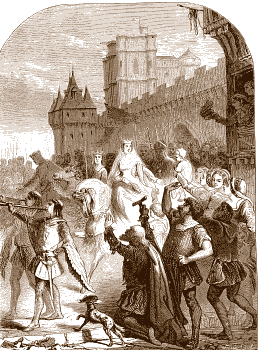
Robert Fawtier- The Capetian Kings of France- Monarchy and Nation (987-1328)
#xiii#robert fawtier#the capetian kings of france#blanche de castille#queens of france#regents#louis viii#louis ix#philippe ii#constance d'arles#robert ii#henri i#anne de kiev#philippe i#bertrade de montfort#adélaïde de savoie#louis vii#étienne de garlande#st bernard#aliénor d'aquitaine#adèle de champagne
6 notes
·
View notes
Note
Do you know that Edmund of Langley, 1st Duke of York's wife Isabella is likely to have an affair with a man from the Howard family and gave birth to the Earl of Cambridge, Richard? Isabella's will was made with Edmund's consent, which may indicate that although Edmund did not want his property to go to Richard, he did not hate their mother and son. Perhaps they were just colleagues who had to have children together
I'm not quite sure I'm following your ask. I think you're asking about Isabel (or Isabella) of Castile, Duchess of York and the assertion that Richard, Earl of Cambridge was a son born from her adulterous liaison? However, the man she was accused of having an affair with was not a member of the Howard family but John Holland (or Holand), Earl of Huntington. Huntington was the son of Joan of Kent and Thomas Holland and thus half-brother to Richard II. Huntington was married to Elizabeth of Lancaster who was the sister of Henry IV, which would have been made things awkward (to say the least) when Richard II was deposed. Huntington was killed during the Epiphany Rising which aimed to restore Richard to the throne. .
Jenny Stratford recently published work arguing that the affair did not take place and that Cambridge was legitimate, as far as we can tell. I'll talk you through the evidence and her arguments against it below the cut.
Thomas Walsingham's commentary on Isabel
Thomas Walsingham wrote that Isabel was:
A lady of sensual and self-indulgent disposition, she had been worldly and lustful; yet in the end by the grace of Christ, she repented and was converted. By the command of the king she was buried at his manor of Langley with the friars, where, so it is said, the bodies of many traitors had been placed together.
Stratford points out that Walsingham got the date of her death wrong, placing it two years after her death occurred, which suggests he was probably not well-informed about his life. She suggests that the image of emerges from Isabel's will contrasts sharply against the image Walsingham provides:
The duchess herself emerges in a favourable light. In face of her husband’s debts, the arrangement to provide an income for the seven-year-old Richard by transferring to Richard II most of her jewels and plate, her personal chattels, was eminently practical. It limited the possibility of claims by the duke’s creditors, while grants previously made to Isabel were subsequently reassigned to fund the annuity. These provisions seem very unlikely to indicate that young Richard was illegitimate, any more than a gap of twelve years between the age of the oldest and youngest of the duchess’s three living children was necessarily significant. The duke’s will drawn up a decade after Isabel’s death speaks of his devotion to her.
It's also worth noting that Walsingham has something of a reputation for misogyny and for being unreliable - we now know that some of his assertions about Alice Perrers's background are groundless and serve to make her appear worse than she was, while Anna Duch argued that he effectively erased Anne of Bohemia from his account of Richard II's reign. He is also full of vitriol for Agnes Launcekrona and Katherine Swynford so it seems to me that we should treat his claims on women with great scepticism.
John Shirley's comments on Chaucer's Complaint of Mars
Forty years after Isabel's death, a scribe named John Shirley wrote an afterword on Geoffrey Chaucer's Complaint of Mars that linked it to a scandal involving "the lady of York" and John Holland. Connected with Walsingham's commentary, it's generally been taken as evidence that they had an affair.
Stratford argues that the Shirley's commentary is likely a garbled reference to the affair between Constance of York (Isabel's daughter) and Edmund Holland, Earl of Kent (John Holland's nephew) which the resulted in the birth of an illegitimate daughter, Eleanor. Following Kent's death, Eleanor claimed claimed her parents had married clandestinely before Kent married Lucia Visconti and that she was his rightful heir but her claims were rejected. Historians have suggested that Kent might have considering marrying Constance before the revelation that she had been involved in a plot against Henry IV meant he distanced himself from her.
Additionally, J. D. North argued that the astronomical framework contained within Complaint of Mars could have only applied to the year 1385 and aligns it with the beginning of the affair between Elizabeth of Lancaster and Huntington. Elizabeth had been married to John Hastings, heir to the earldom of Pembroke, in 1380 when she was 16 and Hastings was 8. However, the marriage was annulled in 1386 and Elizabeth soon after married Huntington on 24 June 1386. It is frequently asserted that Huntington and Elizabeth had embarked on an affair that resulted in a pregnancy, leading to the hasty annulment of Elizabeth's first marriage and her second marriage to Huntington though it isn't clear when their first child was born, though it was in 1386 or 1387. It may be that John Shirley's reference to the affair between "the lady of York" and Huntington may actually be referring to Huntington's affair with Elizabeth of Lancaster.
It may even be that the reference represents a garbled combination of the two affairs - Constance of York and Edmund Holland, Elizabeth of Lancaster and John Holland - recorded decades later. It might be noteworthy in this regard that Elizabeth and Huntington's first child was also named Constance (both Constances were named after Isabel's sister, Constanza or Constance of Castile), which would add to the confusion).
The wills of Cambridge's father and older brother.
The argument that Richard, Earl of Cambridge was illegitimate is based around the lack of reference to Cambridge in the wills of his father and older brother, where it is assumed that this represents that Cambridge was effectively, though not legally, disowned.
His brother, Edward 2nd Duke of York's will was written after Cambridge had been executed as a traitor for his role in the Southampton Plot. His lack of reference to Cambridge may simply be because Cambridge was dead and could not be a beneficiary. There may have also been concern that any reference to Cambridge, such a request for prayers for his brother's soul, could result in suspicion of Edward's own loyalties. From the surviving evidence, Edward also seems to have had a close relationship with Henry V so Cambridge's treason may well have driven a wedge between the brothers. In short: there are a lot of reasons why Edward might have avoided referencing Cambridge explicitly that were far more relevant to the circumstances his will was written in.
Stratford notes that "a testator may not include all his bequests in his will", which would apply to both Dukes of York. Edmund of Langley, 1st Duke of York left "nothing in the will to any of his three children" (my emphasis). He did, however, ask to be buried "near his beloved Isabel, formerly his companion". In short, there is no reason to presume Cambridge's exclusion was due to his being informally disowned by his father due to the adultery of his mother. York's will provides no support to the idea that he had a fraught relationship with Isabel, either.
Isabel's will makes special provision for Richard, Earl of Cambridge.
Isabel's will asked Richard II for provide an annuity of 500 marks for Cambridge against the surrender of her jewels and plate until appropriate lands could be found to furnish him with an income. This has led to the belief that Cambridge would not be supported by his father and brother and, in combination with the above, that this was because he was illegitimate.
Most of this is based on the transcript of her will published in Testamenta vetusta, which is a shortened extract of the full document which didn't include Isabel's many bequests to her husband (if you read something that claims Isabel left York nothing, the author is working from the abridged will, not the full text). Stratford's study is on the original will in its full form. As noted in your ask, Isabel required and received the permission of her husband to make this will. Stratford also notes that some of those mentioned in the will are Edmund, Duke of York's officers who also appear in his will, "strongly suggesting that the duke and the leading members of his familia were in full agreement with its provisions". In short, the idea that York was refusing to acknowledge or provide for Cambridge seems somewhat illogical given his involvement and the involvement of his officers in Isabel's will which was primarily concerned with providing for Cambridge.
Stratford argues that what the will represents is an effort by Isabel and York to provide for Cambridge "while protecting as far as possible the incomes of her husband and his heir."
The principal purpose of Isabel’s will was to provide for their youngest child, Richard, then aged seven. Edmund gave his wife full powers to dispose of her horses, jewels, robes, the furnishings of her chamber, and her other chattels. She made a number of bequests, notably including books, but offered the majority of her valuables to Richard II if he would agree to provide her younger son, his godson (filiol), with an income of 500 marks per year for life. If the king did not so wish, Isabel’s oldest son, then earl of Rutland, was invited to do so on the same terms.
At the time Isabel was drawing up her will, York was heavily in debt following his Portuguese expedition, had difficulty obtaining money due to him from the Crown, and didn't have lands commensurate with his status. York's executors were still struggling to pay his debts eight years after his death and when his eldest son died in 1415, the duchy of York remained bankrupt for twenty years. Stratford notes that the money raised by Isabel's jewels and plate would "circumvent claims on the duke by his creditors".
John Holland gave Isabel a gift.
Isabel's will mentions a "sapphire and diamond brooch" given to her by John Holland, Earl of Huntington which has been taken as evidence of their affair. Sometimes she is also said to have been given a gold cup and a chaplet of white flowers by Huntington, though Stratford points out the brooch is the only item actually said to have been given to her by Huntington and is one of three gifts from named donors (the others was a "little" gold tablet given to her by John of Gaunt and a gaming board of jasper from Leo of Armenia).
Firstly, while gifts of jewels to us seem to be strictly or largely romantic gestures, this very much wasn't the case within the Middle Ages, where the exchange of jewels was a normal part of aristocratic life, albeit serving an important function. We know that medieval nobles frequently exchanged gifts, including items they had been given by others, and it is a pure speculation to assume that Isabel "treasured" the brooch or even that she kept it because it was Huntington who had given to her. Furthermore, it is entirely possible that it was identified through the designation as a gift given to her by Huntington.
Secondly, if this is evidence of their affair which produced Cambridge, it's very odd that she didn't leave Huntington's gift to Cambridge but to her eldest son, Edward, who was York's acknowledged son and heir whose legitimacy has never been doubted.
Isabel left bequests to Holland.
Isabel left her Bibles and "the best fillet I have" to John Holland. Some have argued that this is unusual enough because Holland was the only person she gave gifts to who wasn't a "close member" of her family.
Outside of her husband and three children, Isabel also left bequests to Richard II, Anne of Bohemia, John of Gaunt and Eleanor de Bohun, Duchess of Gloucester, and Stratford groups with Eleanor as a member of Isabel's "wider family" and says it is credible they were friends, not lovers. The extent that Holland isn't a "close" member of her family can be debated: he was married to her niece (Elizabeth of Lancaster) and the half-brother of her nephew (Richard II).
Stratford says that Isabel may have made the bequest to Huntington in hope that that he would influence Richard II and John of Gaunt (who was Huntington's father-in-law and and close ally in the 1380s and named as an executor in Isabel's will) to ensure that the annuity she sought for Cambridge would become a reality.
Furthermore, Stratford suggests that the "best fillet" (which was probably a collar) may have been intended for Elizabeth of Lancaster, Huntington's wife. If so, this would rather point away from it being a memento from their affair.
There were a ten-year gap between Cambridge and his siblings.
The other main piece of evidence put forward is the large gap between Constance of York (b. c. 1375) and Cambridge (b. c. 1385). The supposition usually goes that having had two children (Edward, 2nd Duke of York was born c. 1373), Isabel and York had grown tired of each other's company and didn't have sex again, Isabel then embarked on an affair with Huntington that, some ten years after Constance's birth, left her pregnant and York allowed the child to be brought up as his son but refused to provide for him.
The problem with this scenario is that it is effectively a complete invention. The idea that York and Isabel were at odds is based around the idea of the affair and the speculation Cambridge was illegitimate. York never repudiated Isabel nor officially disowned Cambridge as a bastard. There are many possible reasons why there was such a large gap - fertility issues, miscarriages, bad luck, personal decisions, religious reasons (i.e. choosing to adopt a chaste marriage). Constance's birth may have been particularly difficult and York and Isabel decided not to chance sexual intercourse or to use the contraceptive methods available to them only to slip up. It's also possible that they may had other children who died too young to leave evidence behind and that the large gap between children wasn't that large in reality. After all, it seems we know very little about the births of their children, even the years are uncertain.
I know this is all speculative but so is the argument that they fell out. The point is that we don't have evidence to explain why beyond speculation.
Conclusion
A lot of the arguments for the affair based on tenuous links and are often based on the assumption that the affair was a historical fact and that Walsingham's comments on Isabel are an objective and reasonable account of her character. So the evidence that shows us a connection between Isabel and Huntington is often assumed to be evidence of a sexual relationship.
Take the brooch. It seems to be read as the equivalent of a man buying his lover an emerald necklace or diamond earrings. Except we know that the exchange of valuable jewels as gifts was a common aspect of medieval noble life that performed a vital function that very frequently had nothing to do with romantic or sexual feelings. We know, for example, that Henry VI gave Eleanor Cobham a brooch - it does not follow that they were therefore having an affair or that Henry harboured romantic feelings for his aunt.
That the brooch was mentioned in Isabel's will also tells us nothing. We don't know how she felt about it, only that she singled it out to be passed onto her eldest son (not Cambridge). It may be that she wanted him to have it because of he had admired it and, if it was a feminine piece, may have intended to give it onto his wife when he married. It's quite unremarkable that a medieval individual would identify a piece through noting who had given it to them and is not proof of romantic attachment. Isabel also mentioned gifts given to her by John of Gaunt and Leo of Armenia - should we assume she had affairs with them too?
On a similar note: that Isabel left items to Huntington is taken as proof of their romantic liaison. The bequest? Her best fillet (probably a collar, according to Stratford), which may well have been intended for Elizabeth of Lancaster, and her Bibles. They were likely valuable items but hardly proof of romantic involvement - such bequests were very common and would be utterly remarkable without the context of Shirley's commentary on their relationship.
It seems to me that there is good good reason to believe that John Shirley's commentary on Complaint of Mars, written decades after Isabel's death, may not have been about Isabel at all. She isn't named in the commentary and we have no clear, explicit evidence of this affair outside of the commentary itself. I think it was a garbled recollection of either Isabel's daughter, Constance of York's affair with Edmund Holland, Earl of Kent or of John Holland's affair with Elizabeth of Lancaster. We have clear, contemporary evidence of both these affairs - the existence of Constance's and Kent's daughter and this daughter's attempt to inherit Kent's estates, the annulment of Elizabeth's marriage to Hastings and her marriage to Huntington.
The evidence cited as "proof" of their affair is really nothing of the sort. Isabel's will attempted to provide for Cambridge in the face of York's (comparatively) small income and large debts. Huntington was a beneficiary but hardly the only one and not a particularly unusual choice. He gave Isabel a gift that was in keeping with the social custom of their class and time. York's will mentioned none of his children and he did not officially disown Cambridge. The lack of reference to Cambridge in his brother's will is easy to understand given it was written after Cambridge had been executed for treason. We have no real evidence of discontent between Isabel and York - he was obviously involved in the writing of her will and he requested burial with her in his own. Nor is there any account that records discord between them or separation, like we do for John of Gaunt and Constanza of Castile. York was buried with Isabel, as he had requested, and on their joint tomb-monument are Huntington's coat of arms (amongst many others). It seems very strange to me that York was so utterly furious about Isabel's adultery that he refused to provide for Cambridge, forcing Isabel to beg the king to provide for him, yet he chose to be buried with her, he chose as his second bride Huntington's niece, Joan Holland, and he chose to add the coat-of-arms with the man she had betrayed him with on their tomb monument (which was probably constructed sometime between 1393 and 1399). I don't think this picture holds up.
Walsingham did criticise Isabel for being "worldly and lustful" but Walsingham calling a woman a slut is pretty par for the course for him and he got facts of her life wrong. Nor does he report anything she actually did to deserve such a reputation. In others: scepticism is clearly needed. None of this adds up to very much. It isn't until Shirley wrote his commentary, decades later, that we find any reference to their affair. The rest are things that would be entirely unremarkable without Shirley's commentary directing us to see it as a romantic gesture.
Of course, the fact is that we can't prove she didn't have an affair and that Shirley was really referring to a more evidenced scandal. Proving a negative is hard. Even if we located, exhumed and DNA-tested the bodies of Cambridge, York and Huntington, we might confirm that Cambridge was really York's son (or Huntington's or the son of an unknown man) but we wouldn't be able to prove that Isabel didn't have sex with Huntington at some point in her life. We don't have evidence for every single time a medieval individual had sex and so we can't definitively rule out the possibility that an affair did occur. All we can say is the actual surviving evidence doesn't support the narrative that Isabel had an affair.
It's probably worth noting that Kathryn Warner also read Isabel's full will and still accepts the narrative of Isabel's infidelity, though she argues Cambridge should be given the benefit of the doubt where his illegitimacy is concerned. Personally, I find Stratford's reading of the will more credible than Warner's. I don't think the evidence cited as proof of Shirley's claim is actually evidence of an affair but the existence of a typical relationship between medieval nobles working as normal. Warner seems to contradict herself at times* and she doesn't seem to have been interested in questioning whether Isabel did or did not have an affair. I also think Stratford's extensive work on medieval manuscripts and the inventories of John, Duke of Bedford and Richard II lends credence to her claims.
Works Referenced
Jenny Stratford, "The Bequests of Isabel of Castile, 1st Duchess of York, and Chaucer’s ‘Complaint of Mars’", Creativity, Contradictions and Commemoration in the Reign of Richard II: Essays in Honour of Nigel Saul, eds. Jessica A. Lutkin and J. S. Hamilton (The Boydell Press 2022)
Jenny Stratford, "Isabel [Isabella] of Castile, duchess of Yorkunlocked (1355–1392)", Oxford Dictionary of National Biography (published 2022, updated 2023)
J. D. North, Chaucer's Universe (Oxford University Press 1988)
James P. Toomey (ed.), "A Household Account of Edward, Duke of York at Hanley Castle, 1409-10", Noble Household Management and Spiritual Discipline in Fifteenth-Century Worcestershire (Worcestershire Historical Society 2013).
John Evans, "XIV. Edmund of Langley and his Tomb", Archaeologia, vol. 46, no. 2, 1881
Kathryn Warner, John of Gaunt: Son of One King, Father of Another (Amberley 2022)
(also looked at the ODNB entries for York, Cambridge, Huntington and Elizabeth of Lancaster).
* After mentioning the brooch given to Isabel by Huntington, Warner states: "Isabel did not not mention other gifts she had received from anyone else". In an earlier chapter, Warner says "The 1392 will of Isabel of Castile, duchess of York and countess of Cambridge, reveals that Levon [Leo of Armenia] gave her a ‘tablet of jasper’ during this visit, which she bequeathed to John of Gaunt". Warner also repeats this within the chapter dealing with Isabel's will: "and ‘a tablet of jasper which the king of Armonie [King Levon of Armenia] gave me’ to John of Gaunt". How can Huntington's brooch be the only gift from anyone mentioned in her will when we've been told (twice) that Isabel's will includes a reference to a tablet of jasper gifted to her by Leo of Armenia? Additionally, Warner's arguments seems to be drawn from the preconceived notion that Isabel did have an affair so any evidence connecting her to Huntington must be evidence of the affair, regardless of how limited the evidence is - this is quite surprising, since it goes against one of her arguments against reading Isabella of France and Roger Mortimer's relationship as a love affair.
#ask#anon#isabel of castile duchess of york#john holland earl of huntington#edmund duke of york#richard earl of cambridge#i did just have the revelation cambridge was only a year and a bit older than henry v#god this is long
12 notes
·
View notes
Text
Paul Gavarni and the Junots

A portrait of Constance Aubert, née Junot d'Abrantès, by Paul Gavarni, December 1839.
In the appendix of a biography of Laure Junot sent to me by my friend @apurpledust, I found some poems and an article by the French writer and illustrator Paul Gavarni relating to the Junot family. Laure Junot and her daughters Josephine and Constance were all published writers, and inhabited the same artistic social circle that Gavarni did.
Article by Gavarni about the last volume of the second edition of "Memoirs of the Duchess d'Abrantès", published after her death:
Here we have arrived at the last page of these memoirs of a great lady written by a woman artist: a book in which two celebrities merge, each of which would have sufficed for many ambitions. And as struck as we are by such a rich organization, we are even more struck by the feeling of personal dignity which sustained and developed it. Madame d'Abrantés was a very rare example of this true greatness that events could not achieve. A storm carries away an empire around it, then the years come; she lost almost a throne; and yet she remained with her forehead raised above the crowd. This is what those who seek life in its beautiful aspects will first find in the books she wrote. Read! Sparkling in spirit, a pretty woman, with this great name, this ducal crown, all this gold, all this glory, with how many tributes, and with what tributes the young Duchess of Abrantés must have been surrounded! And she had to resign herself to losing all this, and, having lost all this, find in the superiority of her intelligence a consolation for so many regrets! and make a new life at fifty! another glory! Have we thought carefully about the true nobility in this courage? We cannot dispute this, we artists, born of the people, so proud of our aristocracy because it comes from us, but who see so much nobility in the work. Madame d'Abrantès worked as none of us could do. She not only wrote four times as much as a man of letters, she also drew, she acted, she composed music; or she dug the flowers in her garden, or classified her herbarium, or even embroidered a few tapestries. Must we add to these works the cares of the world, the visits with which she was besieged all day long, the long evening chats, a busy correspondence, to admire this existence so prodigiously active! These are the laudable things the second half of this life endowed with such diverse fame was filled with. The duchess's days had been brilliant, no doubt; but were these not also glorious for the author of the Amirante de Castille? Shouldn't she have seen with legitimate pride crowding around her this young swarm of artists of whom she had become the queen? These friends will say that it was a golden bee torn from the mantle of the Empire and fallen among us. Also the men who usually gathered at the Duchess of Abrantès' house were of two ages and of two kinds: white-haired men with names born from battles won, and men born with the century and becoming names with books, operas or paintings. We saw her smile at these two aristocracies who claimed her as equals, and by whom she was equally honored. Today I remember a charming remark that she said one evening about these double affections: old Mr. Suchet, the brother of the Duke of Albufera, had come unwell that evening to sit in the corner of a small living room where she runs worried about him, exclaiming: “It’s because I really like my old friends!” Then she turned to some of us, and holding out her hand, as if to stop us from being jealous, she added: “And my young ones too, at least!” We all loved him; young and old, we headed towards Chaillot to pay her a sad and last visit, a last procession, and we took her back to the cemetery of Montmartre: there, when we had a little earth thrown on this coffin which forever took this good friend from us, for every funeral oration we cried.
Below the cut are two poems written by Paul Gavarni on the album of Constance Aubert, the second daughter of Laure and Jean-Andoche Junot:
The first poem:
original French:
Les Rêves.
Quel autre monde rêvez-vous? Et que voulait votre âme errante? Loin d'un présent qui désenchante, Où sont vos pensers les plus doux?
Quels chants vous sont mélodieux? Qu'attend la foi qui vous est chère? Et de quel autel solitaire Voyez-vous le ciel de vos dieux?
Si, de beaux jours trop inconstants Vous avez vu venir l'automne, Pour les roses d'une couronne Regrettez-vous quelques printemps?
Où votre âme dans le lointain, Voit-elle un ange sur la route? La magique voix qu'elle écoute Lui dit-elle: "hier" ou "demain"?
Votre orgueil était-il jaloux Du faste des rois de la terre? Et sur un trône imaginaire En secret vous endormez-vous?
Livrez-vous de vastes Etats A des conquêtes idéales? Rêvez-vous l'éclat des cymbales, La palme ou la mort des combats?
Flattant de plus humbles désirs, Peut-être une muse pensive De quelque image fugitive Rajeunit-elle vos loisirs...
Mais, au charme du souvenir, Tout ce qu'on a se décolore: Le passé, que son prisme dore, Brille aux dépens de l'avenir.
Laissez le poète chanter Des plaisirs où son luth convie: Il prodigue à rêver la vie Le temps qu'il a de la goûter.
Dans les plis d'un manteau royal L'ennui s'enveloppe et se cache, Et, dans les combats, le sang tache Les panneaux du char triomphal.
Un moment peut éterniser Les regrets que laisse une idole Dont la scintillante auréole S'évapore au premier baiser.
Mais l'amour, ce léger sommeil, Ce rêve d'un jour vaut la vie... Et qu'importe à l'âme ravie Ce qu'en peut coûter le réveil?
English translation:
The Dreams
What other world do you dream of? And what did your wandering soul want? Far from a disenchanting present, Where are your sweetest thoughts?
What songs are melodious to you? What does the faith that is dear to you await? And from what lonely altar Do you see the sky of your gods?
If, beautiful days too fickle You saw autumn coming, For the roses of a crown Do you regret some spring?
Where you soul in the distance, Does she see an angel on the road? The magical voice she listens to Did she tell him: "yesterday" or "tomorrow"?
Was your pride jealous Of the splendour of the kings of the earth? And on an imaginary throne Do you fall asleep in secret?
Do you deliver vast states To ideal conquests? Do you dream of the brilliance of cymbals, The palm or the death of combat?
Flattering the humblest desires, Perhaps a pensive muse Of some fleeting image Rejuvenates your leisure...
But, to the charm of memory, Everything we have is fading, The past, that its prism gilds, Shines at the expense of the future.
Let the poet sing Of pleasures where the lute is suitable: He lavishes on dreaming of life The time he has to taste it.
In the folds of a royal cloak Boredom wraps itself up and hides, And, in the battles, blood stains The panels of the triumphant chariot.
A moment can last forever The regrets that an idol leaves Whose sparkling halo Evaporates with the first kiss.
But love, this light sleep, This one-day dream is worth life... And what does it matter to the delighted soul What can waking up cost?
The second poem:
original French:
La Pie de la Prison
Du grain qu'ils ont semé, laissez la fleur éclore. Allez! Margot; la loi leur a permis des fleurs. Eh! quoi, méchant oiseau, vous revenez encore De ce triste jardin becqueter les primeurs!
N'en privez pas au moins leurs jours que rien n'abrège; Les ans laissent ici de bien longues saisons, Margot, et de l'hiver ils n'ont eu que la neige; N'allez pas du printemps leur ôter les bourgeons;
Et qu'au moins du soleil un bouquet les console. Demain, le savez-vous! ils attendraient en vain Ce printemps qu'aujourd'hui votre audace leur vole. Margot, les prisonniers vous donnent de leur pain!
Comme cet oiseau noir il est une pensée Qu'ici le malheureux apporte avec ses jours, Qu'il nourrit et son âme et qui, toujours chassée, Dès qu'il voudrait sourire, hélas! revient toujours.
C'est le deuil qui le suit, c'est la voix qui le raille, C'est le regret qui veut de son moindre bonheur; Tourment qui de son lit a remué la paille Et out le bec aigu lui cherche au fond du cœur.
C'est la faim d'être libre. Un oiseau mord la cage; Vous voulez à la vôtre attacher un roseau, Souvenir des jardins dont vous aimiez l'ombrage, Amis, et vous coupez les ailes d'un oiseau!
English translation:
The Prison Magpie
From the seed they sowed, let the flower bloom. Come on! Margot; the law allowed them flowers. Hey! what, wicked bird, you come back again From this sad garden to peck at the early fruits!
Do not deprive them at least of their days which nothing shortens; The years leave many long seasons here, Margot, and all they had in winter was snow; Do not go and remove their buds in the spring;
And may at least a bouquet console them from the sun. Tomorrow, do you know! they would wait in vain This spring that today your audacity steals from them. Margot, the prisoners give you their bread!
Like this black bird, there is a thought That the unfortunate brings here with his days, Which he nourishes and his soul and which, always chased away, As soon as he would like to smile, alas! always comes back.
It is mourning that follows him, it is the voice that mocks him, It is regret that wants his least happiness; Torment which from its bed stirred the straw And the sharp beak searches the depths of his heart.
It's the hunger to be free. A bird bites the cage; You want to attach a reed to yours, Remembrance of those gardens whose shade you loved, Friends, and you clip the wings of a bird!
source
#paul gavarni#gavarni#laure junot#constance aubert#jean andoche junot#napoleonic#history#French history#19th century#poetry#1830s
15 notes
·
View notes
Text
So there once was a woman named Inês de Castro
She was a lady-in-waiting of Constance of Castile a noblewoman
This noblewoman got married with Peter I king of Portugal
Apparently the marriage was arranged against their both will
They didn’t love each other
Instead the king fell in love with Inês
When the queen died King Afonso IV of Portugal, Pedro's father, tried to remarry his son
But Pedro refused to take a wife other than Inês, who was not deemed eligible to be queen
After several attempts to keep the lovers apart, Afonso IV ordered Inês' death
Enraged, Peter revolted against his father
Afonso defeated his son within a year, but died shortly thereafter, and Peter became king
According to legend, Peter later had Inês' body exhumed and placed upon a throne, dressed in rich robes and jewels
He also required all of his vassals to kiss the hand of the deceased "queen"
So now I cannot stop thinking about canon divers where Ed DID DIE
And Stede is so devastated and in grief that he cannot accept this reality
So, he pretends that Ed is still here still alive and well
He places his body on a chair and settee
Let’s make you comfortable love
He dresses him in best clothes
Red looks good on you dear
He gives him jewels and gold
Which one do you like most darling?
The whole crew including Izzy got the creeps but they exhausted and abused and don’t have enough willpower to contradict Stede on this one
Izzy thinks that it is deeply unhealthy but he’s on a guilt trip so he’ll let Stede have it
Especially because Stede asks his opinion how to make things better for “Ed”


#stedward#gentlebeard#ofmd 2#ofmd#ofmd season 2#ofmd s2#stede bonnet#ofmd stede#stede fucking bonnet#ofmd edward teach#edward teach#ed x stede#blackbeard
18 notes
·
View notes
Text
Ages of French Queens at First Marriage
I have only included women whose birth dates and dates of marriage are known within at least 1-2 years, therefore, this is not a comprehensive list.
This list is composed of Queens of France until the end of the House of Bourbon; it does not include Bourbon claimants or descendants after 1792.
The average age at first marriage among these women was 20.
Ermentrude of Orléans, first wife of Charles the Bald: age 19 when she married Charles in 842 CE
Richilde of Provence, second wife of Charles the Bald: age 25 when she married Charles in 870 CE
Richardis of Swabia, wife of Charles the Fat: age 22 when she married Charles in 862 CE
Théodrate of Troyes, wife of Odo: age 14 or 15 when she married Odo in 882 or 883 CE
Frederuna, wife of Charles III: age 20 when she married Charles in 907 CE
Beatrice of Vermandois, second wife of Robert I: age 10 when she married Robert in 990 CE
Emma of France, wife of Rudolph: age 27 when she married Rudolph in 921 CE
Gerberga of Saxony, wife of Gilbert, Duke of Lorraine, and later of Louis IV: age 16 when she married Gilbert in 929 CE
Emma of Italy, wife of Lothair: age 17 when she married Lothair in 965 CE
Adelaide-Blanche of Anjou, wife of Stephen, Viscount of Gévaudan, Raymond III, Count of Toulouse, and later Louis V: age 15 when she married Stephen in 955 CE
Bertha of Burgundy, wife of Odo I, Count of Blois, and later Robert II: age 19 when she married Odo in 984 CE
Constance of Arles, third wife of Robert II: age 17 when she married Robert in 1003 CE
Anne of Kiev, wife of Henry I: age 21 when she married Henry in 1051 CE
Bertha of Holland, first wife of Philip I: age 17 when she married Philip in 1072 CE
Bertrade of Montfort, wife of Fulk IV, Count of Anjou, and second wife of Philip I: age 19 when she married Fulk in 1089 CE
Adelaide of Maurienne, second wife of Louis VI: age 23 when she married Louis in 1115 CE
Eleanor of Aquitaine, first wife of Louis VII and later Henry II of England: age 15 when she married Louis in 1137 CE
Adela of Champagne, third wife of Louis VII: age 20 when she married Louis in `1160 CE
Isabella of Hainault, first wife of Philip II: age 10 when she married Philip in 1180 CE
Ingeborg of Denmark, second wife of Philip II: age 19 when she married Philip in 1193 CE
Agnes of Merania, third wife of Philip II: age 21 when she married Philip in 1195 CE
Blanche of Castile, wife of Louis VIII: age 12 when she married Louis in 1200 CE
Margaret of Provence, wife of Louis IX: age 13 when she married Louis in 1234 CE
Isabella of Aragon, first wife of Philip III: age 14 when she married Philip in 1262 CE
Marie of Brabant, second wife of Philip III: age 20 when she married Philip in 1274 CE
Joan I of Navarre, wife of Philip IV: age 11 when she married Philip in 1284 CE
Margaret of Burgundy, wife of Louis X; age 15 when she married Louis in 1305 CE
Clementia of Hungary, second wife of Louis X: age 22 when she married Louis in 1315 CE
Joan II, Countess of Burgundy, wife of Philip V: age 15 when she married Philip in 1307 CE
Blanche of Burgundy, first wife of Charles IV: age 12 when she married Charles in 1308 CE
Marie of Luxembourg, second wife of Charles IV: age 18 when she married Charles in 1322 CE
Joan of Évreux, third wife of Charles IV: age 14 when she married Charles in 1324 CE
Bonne of Luxembourg, first wife of John II: age 17 when she married John in 1332 CE
Joan I, Countess of Auvergne, wife of Philip of Burgundy, and later John II: age 12 when she married Philip in 1338 CE
Joanna of Bourbon, wife of Charles V: age 12 when she married Charles in 1350 CE
Isabeau of Bavaria, wife of Charles VI: age 15 when she married Charles in 1385 CE
Marie of Anjou, wife of Charles VII: age 18 when she married Charles in 1422 CE
Charlotte of Savoy, second wife of Louis XI: age 9 when she married Louis in 1451 CE
Anne of Brittany, wife of Maximilian I, HRE, Charles VIII and later Louis XII: age 13 when she married Maximilian in 1490 CE
Joan of France, first wife of Louis XII: age 12 when she married Louis in 1476 CE
Mary Tudor, third wife of Louis XII: age 18 when she married Louis in 1514 CE
Claude of France, first wife of Francis I: age 15 when she married Francis in 1514 CE
Eleanor of Austria, wife of Manuel I of Portugal and later second wife of Francis I: age 20 when she married Manuel in 1518 CE
Catherine de' Medici, wife of Henry II: age 14 when she married Henry in 1533 CE
Mary, Queen of Scots, wife of Francis II: age 16 when she married Francis in 1558 CE
Elisabeth of Austria, wife of Charles IX: age 16 when she married Charles in 1570 CE
Louise of Lorraine, wife of Henry III: age 22 when she married Henry in 1575 CE
Margaret of Valois, first wife of Henry IV: age 19 when she married Henry in 1572 CE
Marie de' Medici, second wife of Henry IV: age 25 when she married Henry in 1600 CE
Anne of Austria, wife of Louis XIII: age 14 when she married Louis in 1615 CE
Maria Theresa of Spain, wife of Louis XIV: age 22 when she married Louis in 1660 CE
Marie Leszczyńska, wife of Louis XV: age 22 when she married Louis in 1725 CE
Marie Antoinette, wife of Louis XVI: age 15 when she married Louis in 1770 CE
38 notes
·
View notes
Photo

Et quia solum Guilielmum Capuanorum Principem habebat superstitem, veritus ne eumdem conditione humanae fragilitatis amitteret, Sibiliam sororem Ducis Burgundiae duxit uxorem, quae non multo post Salerni mortua est, et apud Caveam est sepulta. Tertio Beatricem filiam Comitis de Reteste in uxoris accepit, de qua filiam habuit, quem Constantiam appellavit.
Chronicon Romualdi II, archiepiscopi Salernitani, p. 16
Beatrice was born around 1135 in the county of Rethel (northern France) from Gunther (also know as Ithier) de Vitry, earl of Rethel, and Beatrice of Namur.
On her mother’s side, Beatrice descended from Charlemagne (through his son, Louis the Pious), while on the paternal side she was a grandniece of Baldwin II King of Jerusalem (her paternal grandmother Matilda, titular Countess of Rethel, was the King’s younger sister). The Counts of Rethel were also vassals of the powerful House of Champagne, known for its successful marriage politics (Count Theobald IV of Blois-Champagne’s daughter, Isabelle, would marry in 1143 Duke Roger III of Apulia, eldest son of King Roger II of Sicily).
In 1151, Beatrice married this same Roger. The King of Sicily was at his third marriage at this point. His first wife had been Elvira, daughter of King Alfonso VI the Brave of León and Castile and of Galicia, who bore him six children (five sons and one daughter). However, when four of his sons (Roger, Tancred, Alphonse and the youngest, Henry) died before him, leaving only William as his heir, Roger II must have feared for his succession. In 1149, the King then married Sibylla, daughter of Duke Hugh II of Burgundy. She bore him a son, Henry (named after his late older brother), and two years later died of childbirth complications giving birth to a stillborn son. As this second Henry died young too, Roger thought about marrying for a third (and hopefully last) time.
It is possible that Roger’s choice of his third wife had been influenced by the future bride’s family ties with the Crusader royalties as Beatrice was related with both Queen Melisende of Jerusalem and the Queen’s niece Constance of Hauteville, ruling Princess of Antioch. Constance was also a first cousin once removed of Roger, who had (unsuccessfully) tried to snatch the Antiochian principality from her when her father Bohemond II was killed in battle 1130, leaving his two years old daughter as heir.
Beatrice bore Roger only a daughter, Constance, who was born in Palermo on November 2nd 1154. This baby girl (who would one day become Queen of Sicily) never knew her father as he died on February 26th.
Nothing certain is known about her widowed life, although we can suppose she took care of her only daughter. Beatrice died in Palermo on March 30th 1185, living enough to see Constance being betrothed to Emperor Frederick Barbarossa’s son, Henry.
The body of the Dowager Queen was laid to rest in the Chapel of St. Mary Magdalene, together with her predecessor, Elvira, and her step-children, Henry, Tancred, Alphonse and Roger. Through her daughter, Beatrice would become Emperor Frederick II’s grandmother.
Sources
Cronica di Romualdo Guarna, arcivescovo Salernitano Chronicon Romualdi II, archiepiscopi Salernitani Versione di G. del Re, con note e dilucidazione dello stesso
Garofalo Luigi, Tabularium regiae ac imperialis capellae collegiatae divi Petri in regio panormitano palatio Ferdinandi 2. regni Utriusque Siciliae regis
Hayes Dawn Marie, Roger II of Sicily. Family, Faith, and Empire in the Medieval Mediterranean World
Houben Hubert, Roger II Of Sicily: A Ruler Between East And West
SICILY/NAPLES: COUNTS & KINGS
Walter Ingeborg, BEATRICE di Rethel, regina di Sicilia, in Dizionario Biografico degli Italiani, vol. 7
#historicwomendaily#women#history#women in history#historical women#House of Hauteville#Roger II of Sicily#Beatrice of Rethel#norman swabian sicily#costanza i#people of sicily#women of sicily#myedit#historyedit
32 notes
·
View notes
Text

THE DESCRIPTION OF SAINT ELIZABETH OF PORTUGAL The Queen Consort Feast Day: July 4
Elizabeth, daughter of Peter III of Aragon and Constance of Sicily, and the sister of three kings: Alfonso II and James II of Aragon and Frederick III of Sicily, was born in Aljafería Palace, Zaragoza, Kingdom of Aragon on January 4, 1271. At 10 years of age, she was given in marriage to Denis of Portugal, and bore two children, Alfonso, later became Afonso IV of Portugal, and Constance, who married King Ferdinand IV of Castile. Elizabeth is the great-niece of another saint - Elizabeth of Hungary.
Eventually, her prayer and patience succeeded in converting her husband, who had been leading a sinful life. She was modest in her dress, humble in conversation, and charitable towards the poor. It was her habit to provide lodging for pilgrims and to procure dowries for the poor girls of the kingdom.
One of the best moments of her life was the miracle of the roses. Caught one day by her husband, while carrying bread in her apron, the food was turned into roses. Since this occurred in January, Denis reportedly had no response and let his wife continue.
Elizabeth would serve as intermediary between her husband and Afonso, during the Civil War between 1322 and 1324. The Infante greatly resented the king, whom he accused of favoring the king's illegitimate son, Afonso Sanches. Denis was prevented from killing his son through the intervention of the Queen, when she, in 1323, mounted on a mule, positioned herself between both opposing armies on the field of Alvalade in order to prevent the combat. Peace returned in 1324, once the illegitimate son was sent into exile, and the Infante swore loyalty to the king.
In 1325, after the death of her spouse, she retired to the monastery of the Poor Clare nuns, now known as the Monastery of Santa Clara-a-Velha in Coimbra, and entered the Third Order of St. Francis, devoting the rest of her life to the poor and sick in obscurity. During the great famine in 1293, she donated flour from her cellars to the starving in Coimbra. She was also known for being modest in her dress and humble in conversation, for providing lodging for pilgrims, distributing small gifts, paying the dowries of poor girls, and educating the children of poor nobles.
She was a benefactor of various hospitals (Coimbra, Santarém and Leiria) and of religious projects, such as the Trinity Convent in Lisbon, chapels in Leiria and Óbidos, and the cloister in Alcobaça.
She died on July 4, 1336 on her way to Estremoz Castle, where she was supposed to settle a family quarrel. She was called to act once more as a peacemaker, when Afonso IV marched his troops against King Alfonso XI of Castile, to whom he had married his daughter Maria, and who had neglected and ill-treated her.
In spite of age and weakness, the Queen-dowager insisted on hurrying to Estremoz, where the two kings' armies were drawn up. She again stopped the fighting and caused terms of peace to be arranged. But the exertion brought on her final illness. As soon as her mission was completed, she took to her bed with a fever from which she died, and earned the title of 'Peacemaker' on account of her efficacy in solving disputes.
Elizabeth was beatified in 1526 and canonized a saint by Pope Urban VIII on May 25, 1625. Her feast is also kept on the Franciscan Calendar of Saints.
Since the establishment in 1819 of the Diocese of San Cristóbal de La Laguna (Canary Islands, Spain), Saint Elizabeth is the co-patron of the diocese and of its cathedral pursuant to the papal bull issued by Pope Pius VII.
#random stuff#catholic#catholic saints#franciscans#elizabeth of portugal#isabel de portugal#isabel de aragón
1 note
·
View note
Note
⭐
beelzebub/petronella brandt (since nella is the owner and operator of a sugar conglomerate in the dutch providences, interacting with gluttony is - a daily business transaction i imagine), also - kitty howard?
mammon/irene adler (conwoman/thief is nothing BUT greed. and not just for money, or jewels, or infamy. but freedom as well)
lucifer and or asmodeus/anne boleyn and or caterina sforza (pride and lust, though anne is all other manner of things - honestly she could just be a three ring circus of every sin except sloth - these just make sense i think. and caterina literally has so much pride she put the pope to shame and both his sons, soooooo)
leviathan/jane parker aka lady rochford and or angelique bouchard (one is a literal magpie -not actually a bird but attracted to shiny things and or tainting them- and the other did the utmost just cause she was jealous her lover chose someone else, cursing him for all eternity)
belphegor/helena campbell and or constance blackwood (helena daydreams her life away and wants to run away from her circus family to have a normal life/i play her as under the dark mothers sway and is basically just sleep walking through her nightmare existence - and constance....is also delusional, ever smiling, pretending, and overlooking actual murder in her vicinity)
abaddon/olypmias and or joanna of castille (mother of alexander the great "in my womb i gained my vengeance!" and sister of catherine of aragorn, entitled "the mad")

#hellords#thanks so much for sending this in!#i'm sure i could think of others but this seemed like a good starting point!
1 note
·
View note
Text

Constance of Castile becomes Duchess of Lancaster
Following the death of their father, the daughters of Pedro of Castile and his mistress Maria de Padilla (whom he secretly married prior to Blanche of Bourbon) were kept at Bayonne. With nowhere to go, Princesses Constance and Isabella lived under the protection of the Black Prince, having initially served as collateral for Pedro’s promise of payment. The payment never came, and the Princesses now lived in exile as potential heirs to the throne of Castile. According to Froissart, Sir Guiscard d’Angle approached John of Gaunt, Duke of Lancaster, with the idea of marrying into Castile: ‘My Lord, it is time you should think of remarrying. We know of a very noble match for you, one from which you or your heirs will be Kings of Castile. It will be a charitable deed to comfort and advise damsels who are daughters of a King, especially when in such a pitiable state as those ladies are. Take therefore, the eldest as your bride’.
Constance was in every way an ideal choice of royal bride: she was young, beautiful and devout, and she brought to the marriage the promise of a kingdom. Her tragic plight appealed to John’s sense of chivalry. The Duke of Lancaster sent four knights to bring both princesses to Bordeaux. However, he was impatient to secure the match. Rather than waiting and marrying Constance in a grand court ceremony, he rode out to meet her on the road. On 21 September 1371, thirty-one-year-old Gaunt married seventeen-year-old Constance at Roquefort, near Mont de Marsan, and she became the new Duchess of Lancaster. John’s wedding gift to Constance was a gold cup ‘fashioned in the manner of a double rose with a pedestal and lid, with a white dove on the lid’, while Constance gave him the finest gold cup he ever possessed.

By the time Gaunt relinquished his Lieutenancy in Aquitaine in September, he was eager to return home and introduce his new wife to his family, and to the realm. Around the end of the month he sailed from Bordeaux with Constance and her sister Isabella on a salt ship, requesting the ship’s master remove a cargo of bay salt to make the ship available for their voyage. John was attended by a train of Castilian knights wearing the Lancastrian livery, and Constance by a bevy of Castilian ladies. Having shouldered a significant financial burden in Aquitaine, John of Gaunt had little wealth to spare on the luxury of a fine ship; when they arrived in England, Constance was even forced to pawn some of her belongings. On his way to Westminster, John left Constance at Hertford Castle, close to London, one of his favoured country residences. Then in December, John travelled down to Kingston Lacy in Dorset, where he and his bride kept Christmas, feasting on venison and rabbits.

After three months in England, Constance of Castile made her state entry into London. Her long sojourn in the West Country had perhaps been necessitated by her suffering the discomforts and sickness of early pregnancy. Constance was formally welcomed as Queen of Castile by the Black Prince, who had risen from his sickbed and struggled onto a horse for the occasion. He was accompanied by ‘several lords and knights, the Mayor of London and a great number of the commons, well-dressed and nobly mounted’, who conducted the new Duchess ‘through London in a great and solemn procession. In Cheapside were assembled many gentlemen with their wives and daughters to look at the beauty of the young lady.’ This statement suggests that Constance’s physical charms were already renowned. ‘The procession passed in good order along to the Savoy’, where John of Gaunt was waiting to greet his wife. The Black Prince’s welcome gift to his sister-in-law was a golden brooch or pendant depicting St George, adorned with sapphires, diamonds and pearls, while the King presented her with a golden crown set with diamonds and pearls.
Soon afterwards, Constance took up residence at Hertford Castle, where her three Lancastrian stepchildren -Henry, Philippa and Elizabeth- were sent to join her. John of Gaunt assumed the title of King of Castile and León in right of his wife, and insisted his fellow English nobles henceforth address him as 'my lord of Spain’. He impaled his arms with those of the Spanish kingdom. John set up a Castilian chancery that prepared documents in his name and signed by himself with the Spanish formula 'Yo El Rey’ (”I, the King”).

In the summer of 1372 Constance gave birth to a baby girl at Hertford Castle. She was named Katherine – or Catalina, as her mother called her, and as she would one day be known in Castile – and styled Katherine d’Espaigne. Gifts of wine were sent to Hertford that summer, and the Duke was there on 7 July, probably to see his new child. The future looked promising for the new couple. Their union, however, was purely political. There is no evidence of any real love or affection between John and his wife, just mutual courtesy and respect.
After her marriage, although she kept regal state, Constance preferred to live in seclusion with her Castilian ladies in the Spanish manner, residing mainly at the Duke’s magnificent castles at Hertford and Tutbury, biding her time until she could return to her native Castile. Constance was rarely at court. Communication with her husband was probably inhibited by the fact that she spoke little English and he only limited Castilian: seventeen years after their marriage, he had difficulty in following an oration in that language. The marriage survived out of ambition and hatred: John of Gaunt’s ambition for the throne of Castile, and Constance’s hatred for her uncle, Enrique of Trastamara, her father's murderer. However, the real thorn in their marriage was John of Gaunt’s continuing love affair with another woman – Katherine Swynford.
Sources:
Alison Weir, KATHERINE SWYNFORD: THE STORY OF JOHN OF GAUNT AND HIS SCANDALOUS DUCHESS
Helen Carr, THE RED PRINCE: THE LIFE OF JOHN OF GAUNT, THE DUKE OF LANCASTER
Images from youtube's video
youtube
#constance of castile#constanza de castilla#constanza of castile#john of gaunt#pedro of castile#maria de padilla#isabella of castile#spanish history#english history#catherine of lancaster#Youtube
5 notes
·
View notes
Text
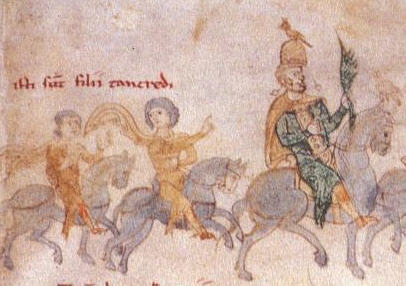

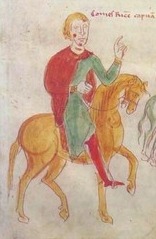

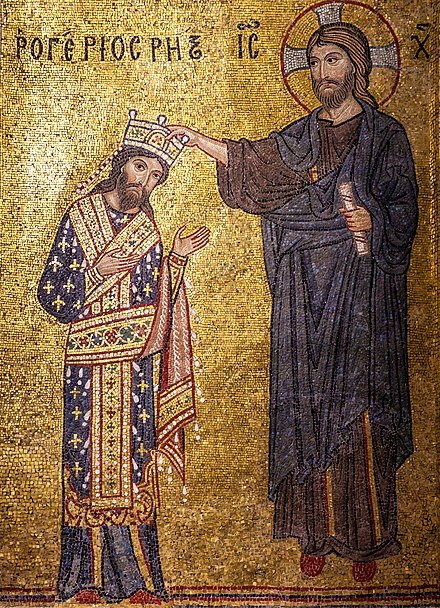

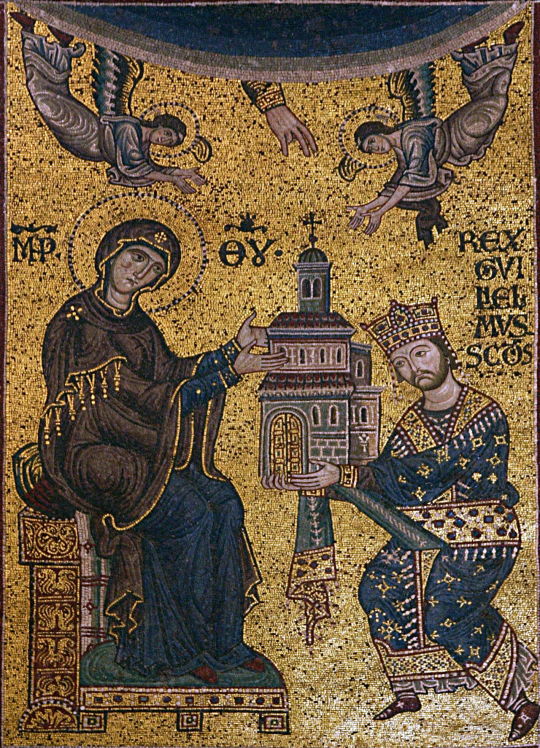


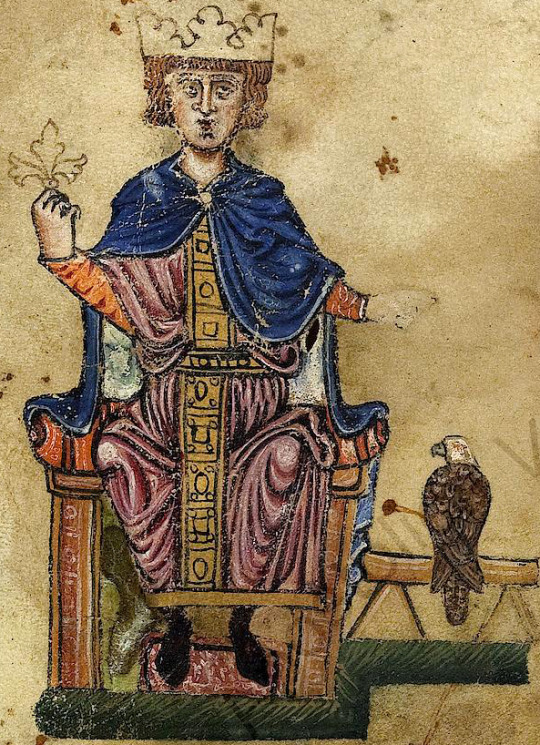
The Bastard Kings and their families
This is series of posts are complementary to this historical parallels post from the JON SNOW FORTNIGHT EVENT, and it's purpouse to discover the lives of medieval bastard kings, and the following posts are meant to collect portraits of those kings and their close relatives.
In many cases it's difficult to find contemporary art of their period, so some of the portrayals are subsequent.
1) Tancred I of Sicily ( 1138 – 1194), son of Roger III of Apulia and Emma of Lecce; with his sons Roger III of Sicily (1175 –1193) and William III of Sicily (c. 1186 – c. 1198)
2) His wife, Sibylla of Acerra (1153–1205), mother of Roger III and William III
3) His brother-in-law, Richard of Acerra (d. 1196)
4)His father, Roger III of Apulia (1118 – 1148), son of Roger II of Sicily and his wife Elvira of Castile
5) His grandfather, Roger II of Sicily (1095– 1154), son of Roger I of Sicily and his wife Adelaide del Vasto
6) His uncle, William I of Sicily (1120/1121 – 1166), son of Roger II of Sicily and his wife Elvira of Castile
7) His cousin, William II of Sicily (1153 – 1189), son of William I of Sicily and his wife Joan of England
8) His aunt, Constance I of Sicily (1154–1198), daughter of Roger II of Sicily and his wife Beatrice of Rethel
9) His uncle, Holy Roman Emperor Henry VI (1165 – 1197), son of Holy Roman Emperor Frederick I and his wife Beatrice I of Burgundy; and Constance I of Sicily's husband
10) His cousin, Holy Roman Emperor Frederick II (1194 – 1250), son of Constance I of Sicily and Holy Roman Emperor Frederick I
#jonsnowfortnightevent2023#asoiaf#a song of ice and fire#day 10#echoes of the past#historical parallels#medieval bastard kings#bastard kings and their families#tancred i of sicily#roger iii of sicily#william iii of sicily#sibylla of acerra#richard of acerra#roger iii of apulia#roger ii of sicily#william i of sicily#william ii of sicily#constance i of sicily#holy roman emperor henry vi#holy roman emperor frederick ii#canonjonsnow
6 notes
·
View notes
Text
Nics
Faith
Grace
Kate
Gibbs
Abby
Ducky
Mcgee
Ziva
Jimmy
Jack
Kasie
Jessica
Jenny
Vance
Tony
Ellie
Nick
Reeves(Clayton)
Alex
Maddie
Kelly
Kayla
Emily
Johnny
morgan
Tobais
Jackie
Ncis new orleans
Naomi
Dwyane
Laurel
Chris
Sonja
Meredith
Loretta
Sebastian
Patton
Tammy
Hannah
Quitnten
Connor
David
Jimmy
natilie
Ncis la
Chris O'Donnell
G. Callen
Main
Peter Cambor
Nate Getz
Main
Recurring
Guest
Recurring
Guest
Daniela Ruah
Kensi Blye
Main
Adam Jamal Craig
Dominic Vail
Main[a]
LL Cool J
Sam Hanna
Main
Linda Hunt
Hetty Lange
Main[b]
Guest
Barrett Foa
Eric Beale
Main[c]
Eric Christian Olsen
Marty Deeks
Guest
Main
Renée Felice Smith
Nell Jones
Main[d]
Guest
Miguel Ferrer
Owen Granger
Recurring
Main[e]
Nia Long
Shay Mosley
Main[f]
Medalion Rahimi
Fatima Namazi
Recurring
Main[g]
Caleb Castille
Devin Rountree
Recurring
Main
Gerald McRaney
Hollace Kilbride
Guest
Recurring
Guest
Recurring
Main
Ncis hawaii
Alex
Julie
Maggie
Carla
Jane
Daniel
Ernie
Kathrine Marie "Kate"
Jesse
Kai
lucy
Rizzoli and isles
casey
lyida
Jane
Maura(dn)
Angela
Vince
Barry
Susie
Nina
Frankie;;
Tommy
Tj
Sean cavangh
Constance
Hope
Calin
Womens murder club
Linsday
Claire
Cindy
Jill
Adein
Elena
Payton
ariel
The truth of a secret
NCIS special agent Todd has a secret that could but the whole team into danger what happens when the news about the death of her dad triggers her powers to become stronger then she ever thought she could she will need to tell them before the nemesis of her youngest sisters best friend strikes again with a changed up mo she will have to reveal the secret to the rest of the team that doesn't know but how did the team take it.
One day after the news and secretly harnessing the new straight over distance training with her sisters (who became stronger as well )and a phone call she decides to tell the team one by one. Helene goes to sleep peacefully in her Alexandria apartment and Kate follows suit in her dc apartment while back in the sisters hometown Maura and Jane follow their night routine falling into bed side by side as they have done for a long time now back in her Beacon Hill home. The next morning Jane and Maura are faced again with the sculpting change in mo and Helene is enjoying a peaceful morning yoga session with both of her sisters and Jane’s as well. After yoga they all go off to work and Kate with a renewed sense of determination to help rid her sisters best friend of her personal nightmare she walks into work and sits down and goes though the files as the rest of the team filters in and she decides to go downstairs to train a bit more before Abby comes in to work. After finishing the training it hits her who it is with the files maura has sent over along with Claire’s on Lindsay’s personal nemesis she races back upstairs to the team all drowned in their own work and Salone waiting for her
Hey Kate whats up i've been waiting
Sorry Jack i was training and going though Mauras and Claires files and i found something
Then what is it Kate
Um i can't say because, she says gustering to her working team mates behind her and what will they think
Katie it won't matter their your family like the Rizzoli’s are mine they haven't treated you any differently sense they found out like my family you owe this to us we all have faith in you,Maura’s voice whispers though her necklace as Jack smiles and nods at Kate's smile and calls the attention of the bullpen
Gibbs and a majority of the team minus Tony looks at Kate's body language and face and smiles and he breaks the silence and gently says what do you got Katie
The jackpot Gibbs the victims all shows signs of multiple serial killers as you all and dr . Mallard after consulting dr. Washburn in san francisco the calling card of the kiss me not killer but if you all could note the missing hands and slit thorout the calling cards of Dennis Rockmond who recently kidnapped dr Isles the chief medical examiner of the commonwealth of massachusetts my home state and the calling card of the surgeon Charles Hoyt who is known for escaping for one condition and to kidnap bpd detective Jane Rizzoli four times for the last time on his deathbed with the me Dr.Isles so it is by my and Ducky’s personal and professional opinion to call them in because there is an fbi card and dna of agent Gabriel Dean on the body who knows all of these details thanks to captain connors and the warehouse shooting and unrelated but subsequent death of both Paddy Doyle jr. and sr and one of which only has three children with mend ceo and founder Hope Martin her only daughter Cailin Martin is a pre med student at bcu as she had previously believed the triplets to be dead but Paddy sent them to Constance and Autor Isles who are both well off in their own way she smiles at her family's photos and whispers to each of them a solo message to her dad you did what you could to protect us were the only thing you'd protect more firmly than your grasp on the city thanks for the letter dad well each read it when where ready i miss you we know you loved us in your own way and made sure Maura and we are safe you ended the terror and had them all turn themselves in each to life setnatnces to her mom and half sister we all love you we knew Maura would be the one to save you but you've made up for lost time see you both when i'm in town and to her mother and father the ones that raised her we all love you you protected us you got me here Helene to bcu and Maura to her best friend see you at the next istation mother thanks for trying and father thanks for trying to heal that rift between us love you both. She smiles and nods to Ducky”make the call as you already ran this by everyone who needs to know. She smiles with slight trepidation until she feels her surge of power knowing her sisters are safe a few hours later.
4 months earlier after Jane and Maura reconciled after the accident. At work the day after Kate loses balance with McGee and Torres on scene immediately knowing her sister over exerted herself and almost leads to her fainting but Gibbs helped them set her down and whispers in her ear(tell them katie) she nods and grasps the gem out of her necklace that hold the outfit that shows her true life and her real family.
Guys i need to show you something but you need to promise me not to tell Tony i can't risk him knowing this
They nod
She smiles and hugs them then here we go she lets the gem go flowing above her head shining brightly as ever and encases Kate in the light changing her outfit and hair to her half sisters hand made leather jacket her leather skirt with black tights and combat boots with a tight fitted dress with a irish flag pin and the crown from her bio dad as the eldest and her mothers bracelet and the choker of mend that they all have and Maura has the headband and Helene has the crown as does Maura they each have their own specially made crowns
Mcgee looks shocked Kate whats going on
Tim i'm not taking my birthright none of us are there all dead or in jail with life threatening harm
Torres us what do you mean by us and what the hell is your birthright
Kate smirks and leans against the tree conjuring all of her patience
I'm the eldest of three Helene Ruyanon Tenured professor at bcu in our homestate and Maura Isles the chief medical examiner of the commonwealth of massachusetts and i'm an Isles not a Todd i didn't want our name to push me ahead i wanted to work for it as did Helene. Maura the youngest and the youngest student in med school top of her class but I'm actually not an Isles weather me and my sisters are adopted. She waves her hand and her normal curls form and her hair slightly lightens while keeping its natural shade. She smirks at the confused looks on their faces and glances over to Gibbs who notices the look in her eyes and backs the team up
Let me show you boys my birthright follows me. They nod dumly and Kate's smirk turns into a smile and she pushes off the tree abruptly grabs their hands turns them into the tree she grabs the gem that the three of them have time to tell you what happened yesterday Jane and Maura reconciled after an accented after our dad's death in the wherehouse swipe he would have shot her but then he wouldn't have anyone to protect his youngest and the princess of the family Maura our mother always had thought we were dead but now with what's happened she knows we aren't but it was for the best with Paddys enemies after us at the time now that's all ended
Wait a minute Paddy Doyle head of the most feared Irish mob in Boston found someone to have kids with can I see something Kate
Kate smirks always Tim don't worry I can change back so he won't know what do you want
Your finger for a print running through the database
You don't believe I'm his eldest abbs has the DNA to prove it and the tunnel of hope in sariavjo
Yes I do Kate and it's true but it's still you none of you are like him
No if anything Maura's like our mom Kate says as the gem shifts her back to her outfit and lands in her hand to be placed back in and she smiles at Gibbs getting back to work he comes up to her just as Tony's arriving to whisper proud of you Katie Tony will know in due time. Kate smiles and nods at his ghost and Gibbs smirks go crazy Kate just make it subtle Doyle
Father daughter share mirror smirks and Kate works away as Tony comes to her side
I told you you'd pay for yesterday well my friend was injured and nows that time I have a little friend she nods at the ghost of her father and he begins the day of crazy and in the end he leaves with one prank with his eldest and this message keep up the good work and help protect your sisters love you my girl she smirks as she sets the last prank up before activating it with the family powers.
A few weeks later after the crazy baker case and Maura didn't want to abandon Jane so they trained together but this time kate had decided to train by rearranging her desk on her break when Jack and Grace walked back downstairs after their appointment and Jack smiles at her keep it up Kate each of you are using your powers for what's needed
It took a few months but the team took it well and they were all more accommodating to her power surges and that leads us to now with her and helene soundly sleeping and or medatanting from the strength of knowing that her sister is safe and with Jane
Gibbs is next to her and says tony needs to know and she smiles in agreement the mind message me and jack should get going if want to meet her. A year after the case they have all moved to be closer to Maura.Kate settles down with her sisters and they each think back to that let those letters that they got one from their mom one from their dad. So as happy for your wedding as I am and I am , I can't wait for the wedding and don't worry Tony won’t know I promise you.
She smiles and nods.
6 months later at the wedding in which both of their mothers and their dad and the whole of the homicide division and crime lab as well as one of Jane's informants the entirety of the rizzoli clan minus frank and almost the whole of the ncis crew and Helene and Cailin and Jill, Cindy and Claire along with Lindsay and Serena and with Abbie. This was the party
Susie was her maid of honor then Isla and Lilly with her sisters along with Cailin as bridesmaids and Jane’s best person is Vince with Barry and her sisters are up alongside the happy couple with the crowd smiling and Angela, Constance and Author along with Hope are crying happy tears. As the event draws to a close they head off on their pre approved month long leave in Paris and promises to help each other train well the others do what they can in the states
A month later they return home Kate to her ever present job with happiness and more pictures to put on her desk as she feels comfortable with the pictures being out because her family knows and that's what matters to her. So this is the order of photos her with her sisters, her mother and the triplets with Constance and Author, and her with the wedding party and the crews as well , Cindy, Jill, Clarie with the wedding party, and a rizzoli family photo as well and of course the solo photos with jane and her sisters and her own as well. The team filters in as Kate finishes up with her family magic in placing the photos on her desk the team that was at the wedding smiles at Kate’s clear happiness for her youngest sister minus Tony she spends that morning training and talking with Jack then she heads back down to make true on the promise to her sister of sketching the wedding party using the wedding family photos as a reference point. She happily sketches away when she answers the call from Linsday who she almost instantly sparked up a kinship with.
Hey Kate
Hey Lins what's up i'm working on the thing i promised Maura
Good good see you in town when your done
Always
She smiles as she ends the call and gets into sketching the family around the wedding party and while she finishes up with Cailin Tony walks up to the desks after his lunch break.
Whats up Katie what are you doing
Sketching and making true on a promise and i have to add color
Abby smiles at the paper and says looking good Katie and I can't wait to see the finished product. It's looking just as good as that day.
Thanks Abbs and of course you will im just about done with it ill be done by tomorrow and i'm taking a sabbatical for a few weeks to help them move Angela and enact their secret plan
Fun
Yep considering they already started and succeeded and Helenes down there with her baby drama
Well tell them congrats from me and the team will fly down toward the end of your sabbatical just promise to keep me updated
I will love you all of you
While in their home town the family will be split four ways and Angela has moved about a month before Helene had her Baby Boy Jackson and Jane and Maura came clean about their plan knowing that they couldn’t hide it any longer. This is the text she sent her the day of each of those events along with a little of the surprising news themselves.
She got it done we each get a fourth of the estate and a fourth of MEND. and everything is going well
Congrats Kate
And Angela is all moved out and they are going to have to tell her considering that their having twins a two lovely girls and their considering naming them after their sisters so yay and Helene’s about ready to pop
Congratulations im glad shes moved out we should be down before the twins are born
Ok plus they framed the picture. And Lindsay and her crew and Abbie and Serena arrived today
Yay. and she also sent her a photo of Jackson the next day with this text he's here he looks just like Helene and you know who has no idea that he exists but he has no rights but welcome the newest member of my family Jackson Michell and he is the cutest and he came home last night and met the whole family even TJ except you guys So were all losing sleep right now.
Yeah i won’t tell the team
Good just a few more weeks for the twins less than two months
Be down soon
#books & libraries#writing#television#ncis#ncis la#ncis hawaii#ncis new orleans#rizzoli and isles#wmc
0 notes
Text
【人物故事】Peter I of Portugal-生死不渝的愛戀,讓「死去」的愛人坐上王座?
如果大家還記得卡斯提爾的康斯坦絲(Constance of Castile)的故事(忘了歡迎回頭看),她的老爸卡斯提爾的佩德羅(Peter(Pedro)of Castile),和爺爺的私生子恩里克(Henry(Enrique) II of Castile)為搶王位而大戰,導致她和妹妹流亡海外。我曾説過要為他另寫一篇故事,但留到以後,今天我要講與其同名的舅舅的故事。 葡萄牙國王佩德羅一世(Peter I of Portugal),不僅和外甥同名,連綽號都一樣,被稱爲「殘酷者」或「正義者」,兩位不僅都是評價兩極的君主,也都為了愛,與整個宮庭為敵,只是舅舅的愛情故事比姪子的更加詭譎。 一切要從卡斯提爾的阿方索十一世(Alfonso XI of Castile)說起,阿方索繼位時尚未成年,他的叔公胡安·曼紐(Juan…

View On WordPress
0 notes
Text

The Coronation of Inês de Castro in 1361 Musée des Beaux-Arts de Lyon
The subject of this painting is borrowed from the history of medieval Portugal. Prince Peter, then married to Constance of Castile, falls in love with one of his followers, Inès de Castro (around 1320-1355). He secretly married her on the death of his wife in 1354. Learning of this union, King Alfonso IV had the unfortunate woman murdered. In order to take revenge, Peter, who became king, had her corpse exhumed in 1366 and had her crowned queen in a macabre staging. The moment represented here is when he forces the great lords to give back to his late wife, sitting on the throne, the honors due to her and to kiss her hand.
1 note
·
View note
Photo





♛ Daughters-in-law of Edward III & Philippa of Hainault
* only their children from the marriages with Edward's & Philippa’s sons are mentioned; the most prominent children are highlighted
#historyedit#joan of kent#elizabeth de burgh#violante visconti#blanche of lancaster#constance of castile#katherine swynford#isabella of castile#joan holland#eleanor de bohun#history#edward iii#philippa of hainault#perioddramaedit#historicwomendaily#gifshistorical#ceremonial#periodedits#women in history#my edit#fancast#*history fancasts
230 notes
·
View notes